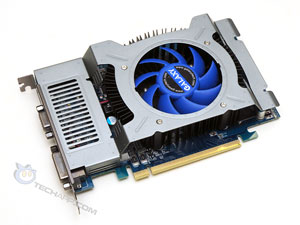The Galaxy GeForce GT 240 (DDR5)
The Galaxy GeForce GT 240 is a short, single-slot graphics card with a large cooler covering most of the top surface. A metal sleeve extended over the entire card, turning what would have been a drearily simple design into something that actually looks good. Quite unlike the dowdy-looking Galaxy GeForce GTX 260+ OC.
Like all new graphics cards, the Galaxy GeForce GT 240 supports PCI Express 2.0 with a 5 Gbps signalling rate. When used with a motherboard that supports PCI Express 2.0, this GeForce GT 240 card will have effectively double the PCI Express bandwidth of PCI Express 1.0 cards.
Of course, that does not mean the Galaxy GeForce GT 240 will be twice as fast as older PCI Express graphics cards. In fact, PCI Express bandwidth will only have a minimal effect on its graphics processing capability. The Galaxy GeForce GT 240 will run fine on your current motherboard even if it only supports the older PCI Express 1.1 standard. It is backward compatible with PCI Express 1.1 and will merely revert to the 2.5 Gbps signalling rate and a lower 8 GB/s bandwidth with these motherboards.
You do not have to worry about PCI Express power cables as this card does not require additional power cables. Thanks to the use of the 40 nm process technology, its thermal design power is only a mere 69 W, so its power requirements can be easily satisfied by the PCI Express bus (which provides for up to 75 W of power). In fact, when it idles, it consumes as little as 9 W. This makes it ideal for use in HTPCs, or PCs that have very puny power supplies.
Specifications
Core / Card Code Name |
• NVIDIA GT215 |
Stream Processors |
• 96 |
Vertex Shader Version |
• 4.1 |
Pixel Shader Version |
• 4.1 |
Textures Per Clock |
• Average 32 |
ROPs |
• 8 |
Core Clock |
• 550 MHz |
Shader Clock |
• 1340 MHz |
Fill Rate |
• 17,600 MTexels/s |
Graphics Memory |
• 512 MB GDDR5 |
Graphics Memory Clock |
• 900 MHz (3.6 GHz QDR) |
Memory Bus Width |
• 128-bits |
Memory Bandwidth |
• 57.6 GB/s |
Bus Support |
• PCI Express 2.0 x16 |
Microsoft DirectX |
• 10.1 |
OpenGL |
• 3.2 |
NVIDIA SLI Support |
• None |
NVIDIA GeForce 3G Vision |
• Yes |
NVIDIA PhysX Support |
• Yes |
NVIDIA CUDA Support |
• Yes |
RAMDAC |
• Two integrated 400 MHz RAMDACs |
CRT Max. Resolution |
• 2048 x 1536 |
DVI Max. Resolution |
• 2560 x 1600 |
Display Support |
• One dual-linked HDCP-enabled DVI-I port |
HDMI Version |
• HDMI 1.3a |
Maximum Board Power |
• 69 Watts |
Idle Board Power |
• 9 Watts |
GPU Thermal Threshold |
• 105 °C |
Card Size |
• 11.12 cm (4.376 inches) tall |
Support Tech ARP!
If you like our work, you can help support out work by visiting our sponsors, participate in the Tech ARP Forums, or even donate to our fund. Any help you can render is greatly appreciated!
<<< Packaging & Contents : Previous Page | Next Page : A Closer Look At The Card, Size Comparison >>>







 Add to Reddit
Add to Reddit


